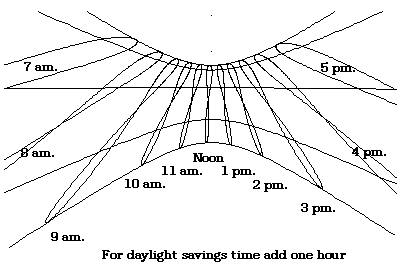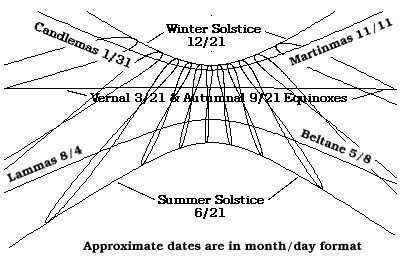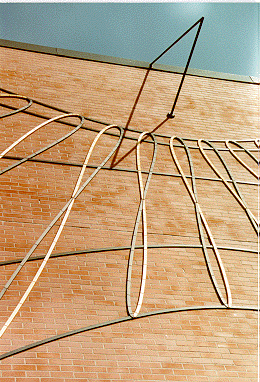UNIVERSITY OF WISCONSIN River Falls
Richard D. Swensen Sundial
How to read the Richard D. Swensen Sundial
The time can be read to the minute only on the hour. For times between the hours you need to estimate. The time and date are indicated by the position of the center of the intersection of the two shadows from the double gnomon.

When the sun is shining on the sundial, the shadows move from left to right across the face of the dial as the day progresses. At each hour the intersection of the shadows falls on the boundary of an analemma. In the spring, half of the year, from December 21 through June 21, the gold colored boundary marks the hour. In the fall, half of the year, the dark brown part of the analemma is used. When estimating the time between the hours, make sure you estimate between the correct boundaries of the analemmas. Gold for spring, brown for fall.

For aesthetic reasons numbers were left off of this sundial. Thus, to determine which hour is indicated, you have to know which analemma corresponds to which hour. In standard time, the hours marked run from 7 a.m. at the left to 5 p.m. at the right. Only parts of the 7 & 8 a..m. and 4 & 5 p.m. analemmas are marked, since in the summer the sun rises behind the sundial and thus does not cast a shadow on the wall. In daylight savings time, from the first Sunday in April until the last Sunday in October, the analemmas indicate the time one hour later than in standard time. Thus the hours marked would run from 8 a.m. through 6 p.m.

The date may also be estimated from the position of the intersection of the shadows. The daylines, which sweep from left to right crossing the analemmas, are calculated for specific positions of the Earth in its orbit around the sun. Since the year is not a whole number of days, we adjust the calendar to keep in step with these astronomical positions or events, in particular the Vernal Equinox, by means of a leap day, February 29. Thus, the date of these astronomical events can vary by a day year to year.

The top day line corresponds to the Winter Solstice, the shortest day of the year when the sun is lowest in the sky, December 21 approximately. On the day of the Winter Solstice, the intersection of the shadows will move along this dayline.
The second dayline from the top corresponds to January 31 in the first half of the year and November 10 in the second half. The first date is close to Candlemas, locally known as Ground Hog Day, Feb. 2. The second date is close to Martinmas, November 11 and is actually the date of Richard D. Swensen's birthday.
The middle dayline which is a horizontal straight line corresponds to the Vernal Equinox and Autumnal Equinox, March 21 and September 21 approximately. On these dates, the intersection of the shadows will move along this line.

The second dayline from the bottom corresponds to May 8 and August 4. The first date is close to Beltane, May 1 and the second is close to Lammas, August 1. The dates of the daylines used were compromises so that a single dayline could be used to represent two days.
The bottom dayline corresponds to the Summer Solstice, the longest day of the year when the sun is highest in the sky, June 21, approximately.
To aid in estimating the date, on days other than those corresponding to those marked by the daylines which are approximately six weeks apart, weekly intervals have been marked on the analemmas. Thus, one can count the number of weeks to the nearest dayline.










